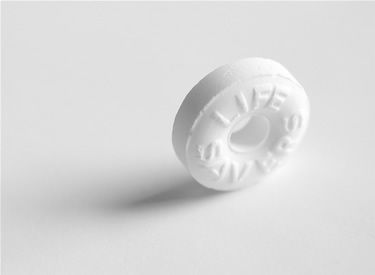A page from the "Causes of Color" exhibit...

Sir Francis Bacon first discovered Triboluminescence, also known as mechanoluminescence, in 1605 when he scraped a lump of sugar with his knife. You can easily replicate the colored light produced from grinding, cleaving, biting, or scratching a crystal at home with a hammer and some Life Savers.
Materials
- At least one roll of Wint-O-Green Life Savers (Note: Do not use sugar-free Life Savers)
- Small piece of wood
- Hammer
How to Do It
- Go into a dark room, such as a large bathroom without windows, a spacious closet, or maybe a laundry room. Wait a few minutes until your eyes adjust to the darkness.
- Using your sense of touch, place a Life Saver in the middle of the piece of wood.
- Keep your fingers away from the mint and smash the Life Saver with a hammer. You should be able to see green luminescent sparks.
- If you didn’t see the sparks, try again, this time smashing two Life Savers together.
- It might be helpful to have another person do the hammering, so that you can focus on seeing the flash of light.
How It Works
The flash of light results from a static electric discharge from fracturing the sugar crystal. The friction of the hammer on the sugar crystals excites the nitrogen air molecules. Chemical bonds in the sugar molecules are broken, providing energy for the electrons in some of the atoms to actually jump around and form positively charged nitrogen ions, which produce a blue or green luminescence. Some ultraviolet energy (visible with a black light) is also produced from the methyl salicylate (oil of wintergreen) so that you will see a blue fluorescent color.
Variations
If you don’t have a hammer, you can try using a pair of pliers or a mortar and pestle.
If you’re in the bathroom or you have a hand held mirror, you can chomp into a Wint-O-Green mint and see the sparks fly between your teeth. We don’t recommend this method, however, since you can chip or damage your teeth.
As an experiment, you can try this with Pep-O-Mint Life Savers. Although these Life Savers do not contain methyl salicylate (oil of wintergreen), they do contain menthol (C10H20O) and sugar.
This phenomenon of triboluminescence can also be seen if you have two samples of milky quartz, which is frequently used in landscaping rocks. Simply rub one crystal against the face (flat side) of the other crystal. In the dark you may notice a faint yellow-orange light. Milky quartz gets its white appearance from microscopic fluid inclusions in the cavities of the quartz, which includes silicon dioxide.
One form of quartzite (a rock, not a mineral) is rose quartz, which contains minor impurities of titanium, manganese, and even colloidal gold. Rose quartz will exhibit triboluminescence if you scratch the face of one crystal with another.




